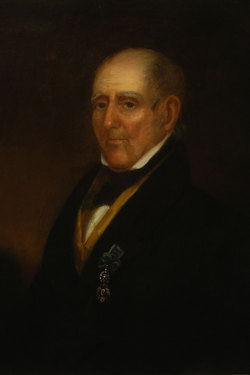Major Aaron Ogden
Original Member, admitted 1783

Major Aaron Ogden
3rd President of the New Jersey Society 1824-1839
In office
1825 — 1829
| Preceded by | John Brooks |
| Succeeded by | Morgan Lewis |
In office
1829 — 1839
| Preceded by | Thomas Pinckney |
| Succeeded by | Morgan Lewis |
In office
1824 — 1839
| Preceded by | Joseph Bloomfield |
| Succeeded by | Ebenezer Elmer |
Ogden entered military service on December 8, 1775, as a paymaster in the militia, where he first saw service in the capture of the Blue Mountain Valley in January, 1776. In November of that year, he took a commission as a first lieutenant in the First New Jersey Continental Regiment, of which his older brother Matthias was lieutenant colonel. He became regimental paymaster the following February, fought at Brandywine, and was made brigade major of William Maxwell’s light infantry brigade on March 7th, 1778. He saw further service as assistant aide-de-camp to General William Alexander.
Ogden was later Maxwell’s aide-de-camp. Following Maxwell’s resignation, Ogden joined LaFayette’s light infantry corps. He also held the distinction of serving as courier during the fruitless negotiations between General Washington and Sir Henry Clinton regarding John André’s execution as a spy for his role in Benedict Arnold’s treason. During the Yorktown campaign, Ogden suffered wounds at the storming of Redoubt Ten on October 14th, 1781.
Following the war, he became a leading lawyer in New Jersey, then rejoined the army as lieutenant colonel when war loomed with France in 1799. He was made quartermaster general of the army before being discharged on June 15th, 1800. From 1801-1803, he served in the United States Senate as a Federalist. In 1812, he was elected governor of New Jersey on a peace ticket but was defeated the following year. President James Madison nominated him to the rank of major general in 1813, apparently with the intention of giving him a command in Canada, but Ogden declined, preferring to retain his command in the state militia.
During the War of 1812, Ogden famously became involved in a steamboat venture. Having built the Sea Horse in 1811, he proposed to operate a line between Elizabethtown Point and New York City, but in 1813 the monopoly of James Fulton and Robert R. Livingston was upheld, and his boat was barred from New York waters. Continued disagreements concluded with a well-known Supreme Court Case, Gibbons v. Ogden, 1824. In 1829 Congress created the post of customs collector at Jersey City for Ogden.
The final years of his life saw him in ceaseless, active involvement in the Society of the Cincinnati, both on the state and national level. As one of the few surviving officers of the Continental Line nearly a half-century after the War’s conclusion, he held the Vice-Presidency of both the New Jersey and General Societies. Ogden was elected President of the New Jersey Society in 1824, the General Society in 1829, and held both at the time of his death in Jersey City on April 19th, 1839.
Sources
Encyclopedia.com
Biographical Directory of the United States Congress, 1774 – Present



